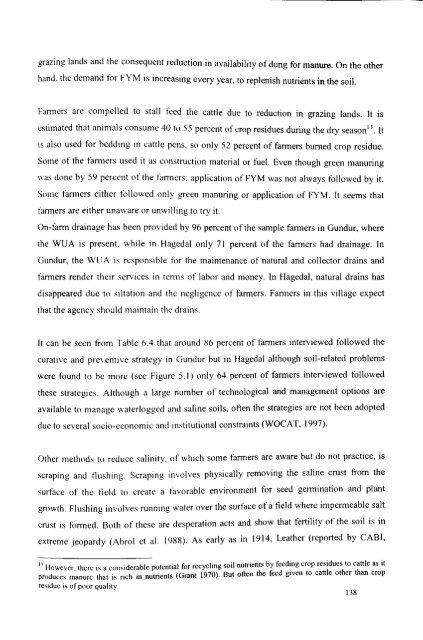Water Users Association and Irrigation Management - Institute for ...
Water Users Association and Irrigation Management - Institute for ...
Water Users Association and Irrigation Management - Institute for ...
You also want an ePaper? Increase the reach of your titles
YUMPU automatically turns print PDFs into web optimized ePapers that Google loves.
grazing l<strong>and</strong>s <strong>and</strong> the consequent reduction in availability of dung <strong>for</strong> manure. On the other<br />
h<strong>and</strong>. the dem<strong>and</strong> <strong>for</strong> FYM is increasing every year, to replenish nutrients in the soil.<br />
Farmers are compelled to stall feed the cattle due to reduction in grazing l<strong>and</strong>s. It is<br />
estimated that animal s consume 40 to 55 percent of crop residues during the dry season 13 . It<br />
is also used <strong>for</strong> bedding in cattle pens, so only 52 percent of farmers burned crop residue.<br />
Some of the farmers used it as construction material or fuel. Even though green manuring<br />
was done by 59 percent of the farmers, application of FYM was not always followed by it.<br />
Some farmers either followed only !,'Teen manuring or application of FYM. It seems that<br />
farmers are either unaware or unwilling to try it.<br />
On-farm drainage has been provided by 96 percent of the sample farmers in Gundur, where<br />
the WUA is present. while in Hagedal only 71 percent of the farmers had drainage. In<br />
Gundur, the WUA is responsible <strong>for</strong> the maintenance of natural <strong>and</strong> collector drains <strong>and</strong><br />
farmers render their services in tenns of labor <strong>and</strong> money. In Hagedal, natural drains has<br />
disappeared due to siltation <strong>and</strong> the negligcncc of farmers. Farmers in this village expect<br />
that the agency should maintain the drains.<br />
It can be seen lTom Table 6.4 that around 116 percent of farmers interviewed followed the<br />
curative <strong>and</strong> preventive strategy in Gundur hut in Hagedal although soil-related problems<br />
were found to he more (sec Figure 5.1) only 64 percent of farmers interviewed followed<br />
these strategies. Although a large number of technological <strong>and</strong> management options are<br />
available to manage waterlogged <strong>and</strong> saline soils, often the strategies are not been adopted<br />
due to several socio-economic <strong>and</strong> institutional constraints (WOCAT, 1997).<br />
Other methods to reduce salinity, of which some farmers are aware but do not practice, is<br />
scraping <strong>and</strong> tlushing. Scraping involves physically removing the saline crust lTom the<br />
surface of the field to create a favorablc environment <strong>for</strong> seed germination <strong>and</strong> plant<br />
!,'Towth. Flushing involves running water over the surface of a field where impermeable salt<br />
crust is <strong>for</strong>med. Both of these are desperation acts <strong>and</strong> show that fertility of the soil is in<br />
extreme jeopardy (Abrol et al. 1988). As early as in 1914, Leather (reported by CABI,<br />
" However. there is a considerable potential <strong>for</strong> recycling soil nutrients by feeding crop residues to cattle as it<br />
. .' . (G t 1970) But often the feed given to cattle other than crop<br />
produces manure that IS rIch In nutrIents ran .<br />
reSidue is of poor quality.<br />
138
















